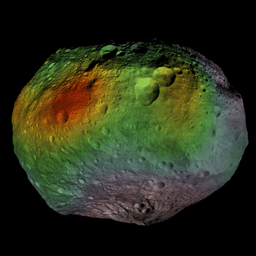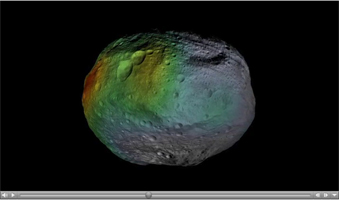
|
Hydrogen Hotspots on Vesta
- Click the image above for a larger view
 Movie Download Options
Movie Download Options- Full-Res JPEG (1024 x 1024) (111.2 kB)
- Full-Res TIFF (1024 x 1024) (3.1 MB)
Caption:

Click on the image for the animation
This animation and still image show that NASA's Dawn mission detected abundances of hydrogen in a wide swath around the equator of the giant asteroid Vesta. The hydrogen probably exists in the form of hydroxyl or water bound to minerals in Vesta's surface.
Scientists thought it might be possible for water ice to survive near the surface around the giant asteroid's poles. But the strongest signature for hydrogen in the latest data came from regions near the equator, where water ice is not stable.
The color scale is shown in the still image. Red indicates the greatest abundances of hydrogen and gray the least, as determined by Dawn's gamma ray and neutron detector (GRaND) instrument while in Dawn's lowest mapping orbit. The hydrogen data were obtained from December 2011 to May 2012. The units are micrograms of hydrogen per gram of surface material.
The GRaND data were superimposed on a mosaic of images and 3-D model of Vesta created from data obtained by the framing camera over the course of Dawn's stay at Vesta. Dawn arrived at Vesta in July 2011 and departed in September 2012.
Background Info:
Dawn's mission to Vesta and Ceres is managed by JPL for NASA's Science Mission Directorate in Washington. JPL is a division of the California Institute of Technology in Pasadena. Dawn is a project of the directorate's Discovery Program, managed by NASA's Marshall Space Flight Center in Huntsville, Ala. UCLA is responsible for overall Dawn mission science. Orbital Sciences Corp. in Dulles, Va., designed and built the spacecraft. The gamma ray and neutron detector instrument was built by Los Alamos National Laboratory, N.M., and is operated by the Planetary Science Institute, Tucson, Ariz.
More information about Dawn is online at http://www.nasa.gov/dawn and http://dawn.jpl.nasa.gov .
Cataloging Keywords:
| Name | Value | Additional Values |
|---|---|---|
| Target | 4 Vesta | |
| System | Main Belt | |
| Target Type | Asteroid | |
| Mission | Dawn | |
| Instrument Host | Dawn | |
| Host Type | Orbiter | |
| Instrument | Framing Camera (FC) | |
| Detector | ||
| Extra Keywords | Color, Movie, Water | |
| Acquisition Date | ||
| Release Date | 2012-09-20 | |
| Date in Caption | ||
| Image Credit | NASA/JPL-Caltech/UCLA/PSI/MPS/DLR/IDA | |
| Source | photojournal.jpl.nasa.gov/catalog/PIA15679 | |
| Identifier | PIA15679 | |
